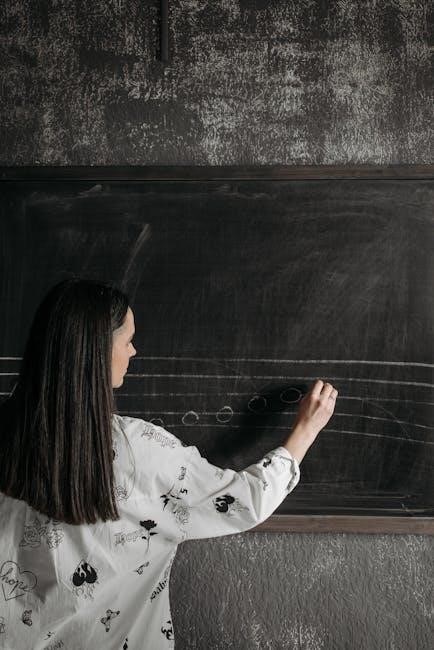Writing in Music demystifies music writing conventions‚ offering strategies for college-level assignments․ This guide helps music majors and students refine their skills‚ blending creativity with technical precision to express ideas clearly and professionally․
1․1 Understanding the Importance of Music Writing
Music writing is a cornerstone of musical communication‚ enabling the precise expression of pitches‚ rhythms‚ and harmonies․ It serves as a universal language for composers‚ performers‚ and analysts‚ bridging creativity and technicality․ By mastering writing in music‚ musicians can convey complex ideas and emotions with clarity․ This skill is essential for composing‚ arranging‚ and interpreting musical works‚ as well as for critical analysis and academic research․ Effective music writing enhances collaboration among musicians and ensures that artistic visions are accurately realized․ Whether crafting melodies‚ harmonies‚ or lyrics‚ the ability to write music empowers creators to share their unique perspectives․ It also fosters a deeper understanding of musical structures‚ making it indispensable for both personal expression and professional growth in the field․
1․2 Brief Overview of the Guide
This guide provides a comprehensive yet concise introduction to writing in music‚ tailored for students and aspiring musicians․ It covers fundamental notation‚ theory‚ and practical techniques‚ offering strategies for effective musical communication․ The guide is structured to help readers navigate the basics of the musical staff‚ clefs‚ note values‚ and time signatures‚ while also exploring advanced topics like chord progressions and songwriting․ With a focus on clarity and accessibility‚ it bridges the gap between theory and practice‚ equipping readers with essential tools for composing and analyzing music․ The guide also includes supplementary materials‚ such as model citations and online resources‚ to support further learning․ By following this guide‚ musicians can enhance their creativity and technical skills‚ ensuring their musical ideas are expressed with precision and impact․
1․3 Target Audience: Music Majors and Students
This guide is specifically designed for music majors and students engaged in undergraduate music-major courses․ It addresses the unique challenges of writing about music‚ offering practical advice and strategies for assignments ranging from brief program notes to lengthy research papers․ The content is tailored to help students develop their analytical‚ compositional‚ and critical thinking skills‚ ensuring they can express their musical ideas with clarity and professionalism․ By focusing on the needs of music students‚ the guide provides essential tools for navigating the complexities of musical notation‚ theory‚ and criticism․ It also serves as a valuable resource for professional musicians and critics seeking to refine their writing skills․ The guide’s clear structure and supplementary materials make it an indispensable companion for academic and professional success in the field of music․

Fundamental Music Notation Concepts
Understanding fundamental music notation is crucial for interpreting and composing music․ This section covers the basics‚ including the staff‚ clefs‚ note values‚ rests‚ time signatures‚ and accidentals‚ essential for musicians and composers to convey musical ideas accurately and effectively․
2․1 The Musical Staff and Clefs
The musical staff‚ consisting of five horizontal lines and four spaces‚ is the foundation of written music․ Each line and space represents a specific pitch‚ allowing for precise notation․ Clefs‚ placed at the beginning of the staff‚ indicate the pitch range and notation system․ The treble clef (G clef) is commonly used for higher-pitched instruments like violins and flutes‚ while the bass clef (F clef) is used for lower-pitched instruments such as cellos and bass guitars; Ledger lines extend above or below the staff to accommodate pitches outside the standard range․ Note heads are placed on the lines or spaces‚ with their position determining pitch․ Stems extend from the note heads‚ indicating rhythm․ Accidentals (sharps‚ flats‚ naturals) modify pitch‚ ensuring accurate interpretation of the score․ Mastering the staff‚ clefs‚ and ledger lines is essential for reading and composing music effectively‚ as they form the visual language of musical communication․
2․2 Note Values and Rests
Note values and rests are fundamental to understanding rhythmic notation in music․ A whole note (open circle) receives the full measure duration in 4/4 time‚ while a half note (open circle with a stem) receives half the measure․ Quarter notes (closed circle with a stem) receive one-fourth of the measure‚ and eighth notes (closed circle with a flag) receive one-eighth․ Rests‚ which represent silence‚ mirror the durations of notes: whole‚ half‚ quarter‚ and eighth rests․ A dot after a note increases its duration by half‚ while beams group eighth and sixteenth notes for clarity․ Mastering these elements allows for accurate interpretation of rhythm‚ enabling precise timing and articulation in musical performance․ Understanding note values and rests is essential for reading and writing musical scores effectively․
2․3 Time Signatures and Rhythmic Notation
Time signatures and rhythmic notation are crucial for understanding the structure and feel of music․ A time signature consists of two numbers: the top number indicates the number of beats per measure‚ while the bottom number specifies the type of note that receives one beat (e․g․‚ 4/4 time means four quarter-note beats per measure)․ Common time signatures like 4/4‚ 3/4‚ and 2/4 dictate the rhythmic framework of a piece․ Rhythmic notation includes symbols like dots‚ beams‚ and rests‚ which modify note durations and organize complex rhythms․ Dots extend note values by half‚ while beams group notes for clarity․ Rests‚ representing silence‚ mirror the durations of notes․ Mastering time signatures and rhythmic notation enables precise interpretation of a composition’s timing and articulation‚ ensuring accurate performance and expression of the intended musical feel․
2․4 Ledger Lines and Note Heads
Ledger lines and note heads are essential for accurately reading and interpreting musical notation․ Ledger lines extend above or below the standard five-line staff to accommodate pitches outside its range․ Each line added represents a specific pitch‚ allowing for a broader tonal expression․ Note heads‚ the circular or oval symbols placed on the staff‚ indicate pitches based on their position․ Open note heads (hollow) and closed note heads (filled) differentiate between whole and half steps‚ respectively․ Stems attached to note heads determine the note’s direction‚ influencing rhythmic interpretation․ Flags on shorter notes (e․g․‚ eighth notes) further modify durations․ Understanding ledger lines and note heads is fundamental for deciphering musical pitches and rhythms‚ enabling precise communication of musical ideas and pitches beyond the staff’s standard range․ This foundation is critical for both reading and writing musical scores effectively․
2․5 Accidentals: Sharps‚ Flats‚ and Naturals
Accidentals—sharps (#)‚ flats (♭)‚ and naturals (∇)—modify a note’s pitch․ Sharps raise pitch by a half step‚ while flats lower it․ Naturals cancel previous sharps or flats‚ restoring the note to its natural state․ Essential for nuanced melodies and harmonies‚ accidentals appear directly before the affected note or in key signatures․ Sharps and flats change a note’s pitch‚ while naturals reset it․ Understanding accidentals is vital for accurate musical interpretation and expression․

Core Music Theory Concepts
Core music theory explores scales‚ key signatures‚ chords‚ and harmonization‚ providing the foundation for composition and analysis․ These elements are essential for creating and understanding musical structures effectively․
3․1 Scales: Major‚ Minor‚ and Their Uses

Scales are the foundational building blocks of music‚ consisting of a series of notes arranged in ascending or descending order within an octave․ Major and minor scales are the most commonly used‚ each with distinct emotional connotations․ A major scale follows the interval pattern of whole‚ whole‚ half‚ whole‚ whole‚ whole‚ and half steps‚ creating a bright and uplifting sound․ Minor scales‚ including natural‚ harmonic‚ and melodic forms‚ produce a moodier and more somber atmosphere due to their differing interval structures․
Understanding scales is essential for composition and analysis‚ as they form the basis of melodies and harmonies․ Key signatures‚ derived from scales‚ indicate the tonal context of a piece․ Mastering major and minor scales enhances a musician’s ability to create and interpret music effectively‚ providing a rich harmonic and melodic vocabulary․
3․2 Key Signatures and Their Significance
Key signatures are a fundamental element in music notation‚ indicating the use of sharps or flats in a composition․ Placed at the beginning of the staff‚ they provide a visual cue for musicians to adjust pitches accordingly‚ ensuring consistency across the piece․ The key signature reflects the tonality of the music‚ whether major or minor‚ and helps establish the overall mood and harmonic structure․
The significance of key signatures lies in their ability to convey the composer’s intent regarding pitch alterations․ They eliminate the need for repeated accidentals‚ streamlining the notation and enhancing readability․ Understanding key signatures is essential for performers to interpret music accurately and for composers to craft cohesive harmonic landscapes․ This foundational concept bridges theory and practice‚ enabling the effective communication of musical ideas․
3․3 Chords: Triads‚ Seventh Chords‚ and Harmonization
Chords form the harmonic foundation of music‚ created by stacking three or more notes in thirds․ Triads‚ the simplest chords‚ consist of a root‚ third‚ and fifth‚ providing a basic harmonic structure․ Seventh chords expand this by adding a seventh note‚ enriching the sound and adding complexity․ These chords are essential for harmonization‚ the process of adding chords to a melody to create depth and texture․
Harmonization involves selecting chords that complement the melody‚ ensuring each note is supported within the chord structure․ This technique enhances the emotional impact of a piece‚ providing a sense of resolution and harmonic direction․ Understanding triads‚ seventh chords‚ and their applications is crucial for composers to craft compelling harmonies that elevate musical expression․
3․4 Chord Progressions and Harmonic Relationships
Chord progressions are sequences of chords that create harmonic movement and structure within a piece․ They are fundamental to songwriting and composition‚ guiding the emotional trajectory of music․ Common progressions‚ such as I-IV-V-I‚ establish a sense of resolution and familiarity‚ while less common sequences can create tension and intrigue․
Understanding harmonic relationships involves recognizing how chords function within a key․ This includes identifying tonic‚ dominant‚ and subdominant chords‚ which form the backbone of most progressions․ Modulation‚ or shifting between keys‚ adds depth and variety․ Effective use of chord progressions enhances musical expression‚ balancing stability and surprise to engage listeners․ Mastering these relationships is essential for crafting compelling and emotionally resonant music․

Bridging Music Theory and Practice
Bridging music theory and practice involves applying theoretical concepts to composition and performance‚ enhancing creativity and understanding․ This connection transforms abstract ideas into practical tools for musicians and composers‚ fostering artistic expression․
4․1 The Relationship Between Melody and Harmony
Understanding the relationship between melody and harmony is crucial for effective songwriting․ Melody‚ the succession of single notes‚ forms the emotional core of a piece‚ while harmony‚ created by simultaneous notes‚ provides depth and structure․ Together‚ they create a cohesive musical experience․ A strong melody often uses stepwise motion within a key‚ while leaps add drama․ The harmonic progression‚ based on chord changes‚ should align with the melody’s emotional arc․ For example‚ a major chord progression supports a joyful melody‚ while a minor progression complements a somber one․ The interplay of tension and resolution between melody and harmony engages listeners‚ creating a dynamic musical journey․ Experimenting with different melodic contours and harmonic progressions helps develop a unique compositional voice‚ ensuring music that is both aesthetically pleasing and emotionally resonant․ This balance is key to crafting memorable and impactful compositions․
4․2 Crafting Effective Melodies
Crafting effective melodies involves balancing creativity with structural clarity․ A strong melody should be memorable‚ emotionally resonant‚ and tailored to the song’s lyrical content․ Stepwise motion creates fluidity‚ while leaps add drama and contrast․ Consider the emotional impact of intervals and their placement within a key; Motifs‚ or short melodic ideas‚ can be developed and varied to build coherence․ The range and tessitura of the melody should suit the vocal or instrumental forces․ Experiment with rhythmic variety to maintain interest‚ ensuring syncopation and rests are used strategically․ A well-crafted melody aligns with the harmonic progression‚ enhancing the overall musical narrative․ By blending simplicity with innovation‚ composers can create melodies that captivate listeners and leave a lasting impression․ This chapter provides practical strategies for refining melodic ideas‚ ensuring they resonate with both technical precision and emotional depth․
4․3 Using Chord Progressions in Songwriting
Chord progressions form the harmonic backbone of a song‚ guiding its emotional trajectory․ Common progressions like I-IV-V-I create familiarity‚ while variations add uniqueness․ Chord choices should complement the melody and lyrics‚ with voicings that enhance texture․ Seventh chords and modal interchange expand harmonic possibilities․ Experiment with tempo and rhythm to shape the feel․ Understanding key signatures aids in selecting chords that fit the tonal context․ Effective progressions balance resolution and tension‚ leading listeners through the song’s narrative․ This section offers insights for crafting memorable and emotionally resonant chord sequences‚ empowering songwriters to express their vision with clarity and depth․ By mastering chord progressions‚ composers can create music that engages and inspires‚ ensuring their work stands out in any genre․
4․4 Experimenting with Musical Structure
Musical structure is the backbone of composition‚ organizing ideas into a cohesive narrative․ Common forms like verse-chorus and AABA provide familiarity‚ while more complex structures‚ such as sonata form‚ offer depth and nuance․ Experimenting with these frameworks allows composers to explore creative possibilities‚ blending tradition with innovation․ For instance‚ extending a bridge or inserting an unexpected interlude can add surprise and engagement․ Understanding how different sections interact—like verse and chorus—enables the creation of dynamic contrasts․ By pushing boundaries while maintaining coherence‚ musicians can craft unique and captivating compositions․ This section encourages exploration of structural variations‚ helping composers develop a personal style that resonates with listeners․ Embrace experimentation to unlock new sounds and stories‚ ensuring your music remains fresh and impactful․

Songwriting Techniques
Songwriting involves crafting melodies‚ harmonies‚ and lyrics․ Understanding verse-chorus structures‚ AABA forms‚ and thematic development helps create compelling songs․ Effective techniques enhance creativity and emotional impact in music composition․
5․1 Understanding Verse-Chorus Structure
The verse-chorus structure is a fundamental framework in songwriting‚ providing a balance between familiarity and contrast․ A typical song follows the pattern of verse 1‚ chorus‚ verse 2‚ chorus‚ bridge‚ and final chorus․ The verse introduces the story or theme‚ while the chorus summarizes and emphasizes the main hook or message․ This structure creates a sense of familiarity‚ making songs memorable and engaging for listeners․ The contrast between verses and choruses adds dynamic variety‚ keeping the audience interested․ Effective use of this structure involves crafting memorable melodies and lyrics that resonate emotionally․ Understanding and mastering the verse-chorus format is essential for writing catchy and impactful songs‚ as it provides a clear and organized way to convey musical ideas․
5․2 Exploring AABA and Other Forms
The AABA form is a popular structural framework in songwriting‚ offering a balance of repetition and contrast․ It consists of three A sections and one B section‚ creating a sense of unity and resolution․ The first A introduces the theme‚ the second A develops it‚ and the B section provides contrast before returning to the final A․ This form is versatile and widely used in various genres․ Other forms‚ such as AAA‚ verse-chorus‚ and sonata form‚ also provide unique ways to organize musical ideas․ Each form offers distinct benefits‚ from the simplicity of AAA to the complexity of sonata form․ Exploring these structures allows songwriters to choose the best framework for their creative vision‚ enhancing the emotional impact and coherence of their compositions․ Understanding these forms is key to crafting engaging and structurally sound music․
5․3 Developing Thematic Material
Developing thematic material is a cornerstone of effective songwriting and composition․ A theme‚ or motif‚ serves as the foundation of a musical piece‚ providing a central idea that can be expanded and varied․ This process involves creating memorable melodies‚ harmonies‚ or rhythms that resonate with listeners․ Techniques such as fragmentation‚ sequence‚ and variation allow composers to explore and elaborate on their themes․ For example‚ a simple motif can be transformed through changes in pitch‚ rhythm‚ or key‚ creating a sense of evolution while maintaining unity․ Thematic development also involves contrast‚ where new ideas or secondary themes are introduced to add depth and interest․ Balancing repetition and variation ensures the music remains engaging without becoming monotonous․ By mastering these techniques‚ musicians can craft compelling and cohesive compositions that captivate audiences and convey their artistic vision․
5․4 Creative Use of Musical Forms
Creative use of musical forms allows composers to innovate while respecting traditional structures․ Forms like sonata‚ rondo‚ and binary provide frameworks for organizing ideas‚ but modern musicians often adapt these structures to suit their artistic vision․ For instance‚ blending elements of verse-chorus with classical sonata form can create hybrid compositions that are both familiar and fresh․ Experimenting with form extends beyond traditional models‚ enabling the creation of unique musical narratives․ By reimagining established forms‚ composers can evoke emotions‚ tell stories‚ or explore abstract concepts․ This approach fosters originality while maintaining coherence‚ ensuring the music remains engaging and meaningful․ Embracing creative freedom within structural guidelines empowers musicians to push boundaries and craft compositions that resonate deeply with audiences․

Resources for Music Writing

Writing in Music offers a companion website with supplementary materials‚ online tools‚ and model citations․ These resources support musicians in refining their skills and enhancing their compositions effectively and professionally․
6․1 Companion Websites and Supplementary Materials
The companion website for Writing in Music: A Brief Guide offers a wealth of supplementary materials designed to enhance learning․ These resources include additional examples‚ strategies for working with sources‚ and practical advice for improving writing skills․ The website provides model music source citations‚ guiding students on proper citation formats for musical works․ Interactive tools and exercises help reinforce key concepts‚ while downloadable resources offer hands-on practice with real-world examples․ These materials cater to music majors and students‚ ensuring they have the support needed to excel in their academic and creative pursuits․ By leveraging these resources‚ learners can deepen their understanding of music writing and apply their knowledge effectively in various musical contexts․
6․2 Recommended Reading for Music Writers
Writing in Music: A Brief Guide recommends essential reading materials to deepen understanding of music writing․ Titles like Music in Words by Trevor Herbert offer practical advice on researching and writing about music‚ from program notes to extensive theses․ Another recommended text is A Short Guide to Writing About Music by Jonathan Bellman‚ which provides concise guidance for students and professionals․ These resources cover various aspects of music writing‚ including analytical techniques‚ historical context‚ and creative expression․ They empower music writers to refine their skills‚ whether crafting academic papers‚ composing music‚ or critiquing performances․ Exploring these recommended readings enriches one’s ability to communicate musical ideas effectively and professionally‚ making them indispensable tools for aspiring composers and writers in the field of music․
6․3 Online Tools for Music Composition
Modern music composition benefits greatly from online tools that enhance creativity and efficiency․ Platforms like NoteFlight and Flat offer robust music notation software‚ allowing composers to create‚ edit‚ and share scores digitally․ Soundtrap and GarageBand provide digital audio workstations (DAWs) for recording and producing music‚ ideal for both beginners and professionals․ Websites like Loopmasters supply high-quality samples and loops to inspire new ideas․ Additionally‚ online tools like MIDI converters and chord progressions generators simplify tasks such as transcribing music or brainstorming harmonies․ These resources empower musicians to explore diverse genres and styles‚ fostering innovation in their work․ By leveraging these tools‚ composers can streamline their workflow and focus on bringing their musical visions to life‚ making the creative process more accessible and enjoyable than ever before․

6․4 Model Music Source Citations
Model music source citations are essential for accurately crediting musical works and sources․ The companion website for Writing in Music: A Brief Guide provides examples of proper citations for various musical sources‚ ensuring clarity and consistency․ These models cover sheet music‚ audio recordings‚ and digital resources‚ guiding users on how to cite them correctly․ Proper citation is crucial for academic integrity‚ especially when referencing compositions‚ arrangements‚ or analyses․ The guide emphasizes the importance of understanding different citation styles and applying them appropriately․ By following these models‚ musicians and writers can avoid plagiarism and give proper credit to original creators․ This section is a valuable resource for anyone seeking to master the art of citing musical sources effectively‚ ensuring their work is both professional and ethically sound․
Mastery of music writing enhances creativity and communication․ Continuous learning and practice refine skills‚ enabling composers to express ideas with clarity and emotion‚ fostering growth and artistic excellence․
7․1 The Importance of Music Writing Skills
Music writing is a cornerstone of musical expression‚ enabling creators to communicate ideas with precision and emotion․ It fosters creativity and technical mastery‚ allowing composers to bring their vision to life․ Effective music writing bridges the gap between inspiration and execution‚ ensuring that musical concepts are conveyed clearly․ For musicians‚ it enhances collaboration and interpretation‚ providing a universal language․ Professionals rely on these skills to produce high-quality compositions and arrangements․ Developing music writing abilities empowers artists to explore diverse styles and genres‚ pushing creative boundaries․ Ultimately‚ it is an essential tool for preserving and innovating musical traditions‚ ensuring that compositions resonate with audiences for generations․
7․2 Final Tips for Aspiring Composers and Writers

For aspiring composers and writers‚ mastering music writing involves a blend of creativity and technical skill․ Begin by understanding fundamental notation and theory‚ as these form the backbone of effective composition․ Experiment with diverse musical forms and styles to discover your unique voice; Collaborate with fellow musicians to gain new perspectives and refine your craft․ Stay persistent‚ as developing your skills takes time and practice․ Leverage resources like Writing in Music: A Brief Guide for practical advice and strategies․ Finally‚ remain open to feedback and willing to revise‚ as these are essential for growth․ By embracing these tips‚ you can unlock your full potential and create music that resonates with clarity and emotion․
7․3 The Value of Continuous Learning in Music
Continuous learning is essential for growth in music writing‚ as it fosters creativity‚ adaptability‚ and mastery of evolving techniques․ Musicians and composers should embrace lifelong learning to stay informed about new trends‚ tools‚ and methodologies․ Engaging with resources like Writing in Music: A Brief Guide and online platforms provides access to fresh insights and strategies․ Regular practice‚ experimentation‚ and exploration of diverse genres enhance skill development․ Collaborating with peers and seeking feedback can refine your craft and open new creative avenues․ By committing to continuous learning‚ musicians cultivate a deeper understanding of their art‚ enabling them to express ideas with precision and emotion․ This dedication not only enriches personal growth but also contributes to the dynamic evolution of music itself․



